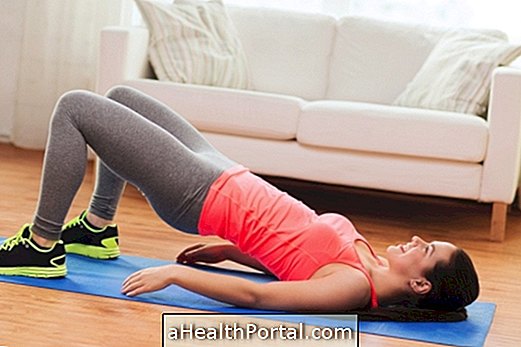To correct bad posture it is necessary to correctly position the head, to strengthen the muscles of the back and the abdominal region because with the weak abdominal muscles and erector of the spine there is a tendency for the shoulders to be lowered and facing forward, proportionate to known hyperkinesis popularly as 'hump', which is one of the most common types of bad posture.
What can be done to correct this posture, with shoulders down at the front, includes:
- Exercise regularly;
- Have body awareness and make small adjustments throughout the day;
- When sitting, make sure you sit on the butt bone and keep your back on the chair and your feet on the floor;
- When standing, you should maintain the upright posture and distribute the weight of the body on the 2 feet at the same time, avoiding lateralizing the hips.
People who sit more than 5 hours a day should pay special attention to the way they sit on the chair or sofa to avoid kyphosis, which is when the thoracic spine becomes more 'sideways' when viewed from the side.
For this it is essential to have body awareness and keep the abdominal muscles contracted, performing a small contraction, which consists of 'shrinking the belly', bringing the belly button more in and up the abdomen. This small contraction activates the transverse abdominal and diaphragm muscles which also help maintain good posture.
Exercising to correct shoulder posture
Exercising in the gym or practicing Pilates regularly also helps maintain good posture because it strengthens the muscles contributing to the treatment to improve posture. In addition it is recommended to do stretching daily to increase the elasticity of the muscles, and therefore Pilates exercises take advantage, because they require a good body stretching.
Watch a series of 8 Pilates exercises that you can do regularly to strengthen your back and improve your posture:

Do I need a vest to correct posture?
It is not recommended to wear vests to correct posture because they act contrary to physical therapy and tend to aggravate the situation in the long run. This can happen because the jackets force the shoulders back but do not strengthen the muscles properly, leaving them more elongated than they should be. This imbalance in muscle strength damages the spine, and furthermore, one of the secrets to correcting fallen-shoulder posture is not to reach the shoulders back but to correct the position of the head, which is usually more anterior.
How to Correct Lumbar Posture
The final part of the spine should always be in the neutral position, without the hip bone facing forward or backwards, which can rectify the spine or leave the buttocks more upturned when viewed from the side. A good exercise to correct the lumbar posture is to find the neutral position of the hip and for this it is due to:
- Stand with your legs slightly apart, bend your knees a little and slowly move your hip back and forth. It may be helpful to do this test by looking at yourself in a full-length mirror, laterally, and then checking for rectification or hyperlordosis. The challenge is to maintain the neutral position of the hip, there being no exaggerations in the curvature of the spine.

To combat hyperlordosis : what you can do is a stretching exercise that consists of lying on your belly up, flexing your legs and hugging them, remaining in that position for a few seconds. Repeat the exercise 5 times.
To combat lumbar rectification : A good exercise is to lie on your belly and place a ping pong ball where the curvature of the spine should be and hold that position for a few seconds. Remember to never put body weight on the ball.
For best results it is important to consult a physiotherapist for an individual assessment, especially if there are back pains.
How To Correct Sleeping Posture
To correct the posture during sleep one should sleep in a proper body position. The ideal is to lie on your side, with a small pillow between the knees and a pillow to support the head well, so the spine can stand erect when viewed from the side. If possible look at the mirror in this position or ask another person to see if the spine is apparently well positioned.
When sleeping belly up, you should use a lower pillow and put another pillow under your knees. Sleeping on the stomach is not advised. Check out more details at: Find out the best Mattress and Pillow for you to sleep better.
When to do physiotherapy
It is recommended to go to the physiotherapist when you have back pain, shoulders, neck or tension headache, especially if you have any deviations of the spine, presenting poor posture.
The main postural changes are anteriorized; hyperkyphosis, popularly known as hunchback; hyperlordosis, and also the lateral deviation of the spine that is scoliosis. All these situations need to be corrected as soon as possible to avoid back pain, headaches, which also helps prevent other more serious situations, such as herniated disc and sciatic nerve involvement, for example.
In order to correct the vicious posture that causes back pain, for example, it may be necessary to perform a specific treatment through advanced physical therapy, which involves static exercises, guided by the physiotherapist. But before starting the treatment it is necessary to carry out a thorough evaluation of the posture to know the deviations that the person possesses, and to guide the exercises of stretching and strengthening more indicated for each person, because the series of exercises is usually individual, because every human being is unique.


















